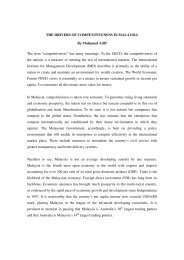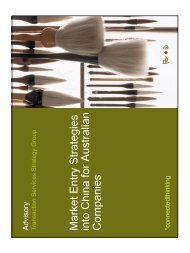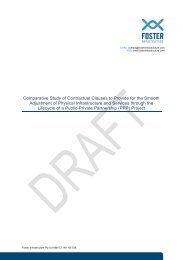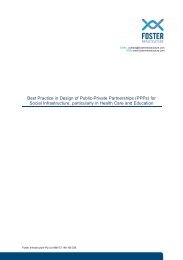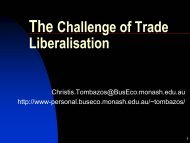Coping with change - Farm level adjustment and policy reform
Coping with change - Farm level adjustment and policy reform
Coping with change - Farm level adjustment and policy reform
You also want an ePaper? Increase the reach of your titles
YUMPU automatically turns print PDFs into web optimized ePapers that Google loves.
Transitionalassistance for <strong>policy</strong><strong>reform</strong> in AustraliaAustralia does not give long termcompensation to the ‘losers’ of<strong>policy</strong> <strong>reform</strong>. But transitionalassistance has been provided incertain circumstances. It usuallyreflects the social welfare <strong>and</strong>equity issues associated <strong>with</strong> theeffects of the <strong>reform</strong>. The keyprinciple in providing assistance isto use measures that will facilitate<strong>change</strong> <strong>and</strong> the transition ofresources.Two recent experiences ofAustralian <strong>policy</strong> <strong>reform</strong> are worthexamining. They demonstratethe relationship between a major<strong>policy</strong> <strong>reform</strong> <strong>and</strong> the subsequentstructural <strong>change</strong>. They alsoused different approaches in theprovision of transitional assistance.The two examples are:• the dairy industry <strong>and</strong> the overnightelimination of marketsupport following a lengthyperiod of phased reductions inassistance for manufacturingmilk; <strong>and</strong>• the citrus industry <strong>and</strong> a phasedreduction in tariff protection.Dairy deregulation was an unusualexperience in <strong>policy</strong> <strong>reform</strong>. It wasthe final act of a <strong>reform</strong> processthat began 14years earlier <strong>and</strong>was supportedby most of theindustry. Followingtwo years ofdiscussions betweenthe industry <strong>and</strong>government thedecision wasannounced ninemonths before itwas implemented<strong>and</strong> there was someuncertainty about the implicationsfor milk prices. Initially averagereturns fell by up to 18% in thestates that focused on fluid milksales <strong>and</strong> there was a substantialreduction in farm incomes.A number of dairy farmers retiredfrom the industry – farm numbersdeclined by more than 17%during the first three years of aderegulated market (table 2). Butmost other farmers reacted to thedecline in returns by exp<strong>and</strong>ingoutput. After a short period of<strong>adjustment</strong> there was a recovery inmilk production <strong>and</strong> the industry’sexport performance has beenmaintained.The government providedrestructuring assistance to helpfarmers adjust to the effects ofthe <strong>reform</strong>. Transitional assistanceworth A$1.74 billion was providedto all farmers in the form of a grantbased on their individual exposureto the price support measures. Thegrants were an explicit paymentin place of the implicit assistancethat would have been obtained ifa phased approach to <strong>reform</strong> hadbeen adopted.The dairy assistance wasdecoupled from current or futureproduction decisions. There wereno conditions on how the grantcould be used <strong>and</strong> no requirementto exit the industry. Most farmerswho remained in the industry usedthe grant for financial <strong>and</strong> on-farmrestructuring.Structural <strong>change</strong> in the citrusindustry is a more typicalexperience of trade related <strong>policy</strong><strong>reform</strong>. It was a phased approach2. Australan dairy industry <strong>adjustment</strong> to <strong>policy</strong> <strong>reform</strong>Year ending 30 June 1999-00 2000-01 * 2001-02 2002-03 ** 2003-04 **pre-<strong>reform</strong>← → post <strong>reform</strong> periodNumber of farms number 12 896 11 839 11 048 10 654 9 611<strong>change</strong> - 260.0 -1 057.0 - 791.0 - 394.0 -1 043.0Output per farm '000 litres 842 891 1 020 969 1 048% <strong>change</strong> 8.8 5.9 14.5 -5.0 8.1Herd size head/farm 168 184 192 192 211% <strong>change</strong> 2.8 9.1 4.5 0.1 9.7Milk yield litres/head 4 996 4 847 5 309 5 038 4 965% <strong>change</strong> 5.8 -3.0 9.5 -5.1 -1.4Milk production m litres 10 847 10 547 11 271 10 326 10 075% <strong>change</strong> 6.6 - 2.8 6.9 - 8.4 - 2.5Dairy product exports '000 tonnes 776 729 786 722 647% <strong>change</strong> 17.8 - 6.1 7.8 - 8.2 - 10.3* Market deregulation occurred on 1 July 2000. Source: Harris 2005a.** Widespread drought conditions.
to <strong>reform</strong> where orange growerswere given time to adapt to a<strong>change</strong> in market conditions.From 1988-89 the industry had toadjust to a reduction in the tariffon frozen concentrate orange juice(FCOJ) from 35% to 5% over aneight year period.The effect of the <strong>reform</strong> wasamplified by a decline in the worldprice for FCOJ. Market pricesfor processing fruit declined by45% during the implementationperiod. Some growers left theindustry <strong>and</strong> some diversified intoother products. Others <strong>change</strong>dtheir fruit varieties to reduce thedependence on processing fruitsales (table 3). There was no longterm industry contraction <strong>and</strong> theindustry’s export performance hassignificantly improved.The citrus <strong>reform</strong> wasimplemented in a way thatprovided implicit transitionalassistance as growers did nothave to immediately absorb thefull effect of the tariff cut. Thepressure on returns led to industryrequests for extra assistance. Thegovernment responded <strong>with</strong> anA$8.4 millionindustrydevelopmentprogram towardsthe end of theimplementationperiod.The citrusprogramprovidedassistance forprojects aimed Orange treesat improvingindustrycompetitiveness.It did not provide any directassistance to growers. Instead itprovided indirect assistance thatencouraged growers to take aparticular course of action in their<strong>adjustment</strong> decisions.The key point that emerges fromthese two experiences is thatfarmers were able to adjust tothe <strong>change</strong> in market conditions.Some older farmers retired <strong>and</strong>some moved into jobs outsideagriculture. Those that remainedtook steps to improve theperformance of their farm business<strong>and</strong> in both cases the industryperformance improved after aperiod of <strong>adjustment</strong>.The impact of both <strong>reform</strong>s wasnot as severe as expected <strong>and</strong> thetransitional assistance helped tofacilitate the structural <strong>change</strong>.The key principles were theassistance was provided for alimited period <strong>and</strong> market pricesdirected the <strong>adjustment</strong>. Itshowed that long term incomesupplements are not requiredto sustain an industry after theremoval of industry supportmeasures.3. Australian citrus industry <strong>adjustment</strong> to <strong>policy</strong> <strong>reform</strong>Year ending 30 June 1987-88 1992-93 * 1997-98 2002-03 **pre-<strong>reform</strong>← →post<strong>reform</strong> periodTotal orange crop '000 tonnes 486 691 566 633- processing fruit '000 tonnes 293 397 279 309% share of crop 60.3 57.5 49.3 48.8- export sales '000 tonnes 48 82 117 133% share of crop 9.9 11.9 20.7 21.0Gross value of production A$m 151 215 258 337Unit value of production A$/tonne 306 344 516 562Sales of processed orange fruit '000 tonnes 292 450 487 655FCOJ imports ^ '000 tonnes 14 64 229 378- market share % share 4.8 14.2 47.0 57.7World price of FCOJ A$/t 3 338 1 206 1 288 1 496- price in Australian market A$/t 4 547 1 595 1 555 1 807* FCOJ import tariffs progressively reduced from 35% in 1988-89 to 5% in 1996-97. Source: Harris 2005b.** Widespread drought conditions.^ Fresh fruit equivalent.
ConclusionsAdjusting to the pressures for<strong>change</strong> is an inevitable aspect ofindustry development. Australianfarmers have shown considerableresilience <strong>and</strong> capacity to adaptto changing market conditions.Fluctuations in world prices<strong>and</strong> ex<strong>change</strong> rates affect farmreturns in most industries. Butthe Australian experiences showfarmers can successfully adapt <strong>and</strong>there is no reason farmers in othercountries could not do the same.The two experiences of <strong>policy</strong><strong>reform</strong> demonstrate that farmerswere able to adjust to a significant<strong>change</strong> in market conditionscaused by reductions in support.Some older farmers retired <strong>and</strong>some moved into jobs outsideagriculture. Those that chose toremain were not passive marketparticipants. They took steps toimprove the performance of theirfarm business <strong>and</strong> in both cases theindustry performance improvedafter a period of <strong>adjustment</strong>.The impact of both <strong>reform</strong>s wasnot as severe as expected <strong>and</strong> thetransitional assistance helped tofacilitate the structural <strong>change</strong>. Thekey principles were the assistancewas provided for a limited period<strong>and</strong> market prices directed the<strong>adjustment</strong>. It shows that longterm income supplements are notrequired to sustain an industryafter the removal of marketsupport measures:• farmers make structural<strong>change</strong>s that can improveindustry performance whentheir income position <strong>change</strong>s;• income support weakens theincentive to make <strong>adjustment</strong>s– farmers are less responsive tothe <strong>change</strong> in returns that comefrom <strong>policy</strong> <strong>reform</strong>.The aim of transitional assistancefor <strong>policy</strong> <strong>reform</strong> should be toEvedon Park Bush ResortThe Jenour family have farmed the property at Evedon Park since the late 1960s. Theproperty supported beef cattle, fat lambs <strong>and</strong> dairy cattle over the years. In 1984 theydiversified into a bush resort <strong>and</strong> since then have gradually grown the development so thatit is now a popular venue for conferences, seminars <strong>and</strong> meetings as well as bush holidays.Source: Options for Change-New Ideas for Australian farmers, RIRDC Publication 03/030facilitate <strong>change</strong> rather thanprovide a longer term welfarepayment which can stifle theincentive for self improvement.The best way to facilitate structural<strong>change</strong> is to make the full impactof the <strong>reform</strong> transparent. Thisalso means transitional assistancewill be more effective if it istransparent.A phased approach to <strong>reform</strong> wasused for the Australian citrusindustry. It delayed the full impacton farm returns <strong>and</strong> gave growerstime to adjust. This approachprovides some implicit transitionalassistance but it can lead to alonger <strong>adjustment</strong> process. It is nota transparent form of assistance asit gets mixed up <strong>with</strong> others factorsaffecting market returns.An overnight approach was usedfor the final act of <strong>reform</strong> inthe Australian dairy industry. Itincluded a one-off restructuringgrant instead of the implicitassistance from a phased approachto <strong>reform</strong>. The assistancewas transparent <strong>and</strong> farmersgot immediate, undistortedprice signals on the full effectsof the <strong>reform</strong>. It created astrong incentive for farmers toimmediately assess their futureprospects <strong>and</strong> consider theiroptions for <strong>change</strong>.<strong>Coping</strong> <strong>with</strong> <strong>change</strong> is not easy.When faced <strong>with</strong> the effects of<strong>policy</strong> <strong>reform</strong> farmers will adjustin different ways. It depends onindividual circumstances <strong>and</strong>the opportunities to improvethe physical <strong>and</strong> financialperformance of their farms. Thesocial dimensions of <strong>change</strong> canbe managed <strong>with</strong> transitionalassistance as an element of the<strong>policy</strong> <strong>reform</strong>:• the Australian experiencesindicate the best approachis to use limited, short termassistance that does notdictate the way farmers shouldrespond;• the income effects of the<strong>change</strong> in market returnsshould be allowed to shape the<strong>adjustment</strong> process.
Industry Adjustment toTrade Related Policy Reformby David HarrisThis report investigatessome Australian experiencesof industry <strong>adjustment</strong> to<strong>policy</strong> <strong>reform</strong>. Four industrycase studies are examined– dairy, citrus fruit, pig meat<strong>and</strong> rock lobsters. Each casestudy involved a differenttype of <strong>policy</strong> <strong>change</strong>. Thethree agricultural industrieshave experienced <strong>adjustment</strong>pressures from trade related<strong>policy</strong> <strong>reform</strong>s. The rocklobster industry has adjustedto the removal of open accessrights to a naturally occurringresource.RIRDC Publication No.05/173,110 pages, $26Industry Adjustment toPolicy Reform – A case studyof the Australian dairyindustryby David HarrisThe Australian dairy industryhas recently experienced a<strong>policy</strong> <strong>reform</strong> that involvedthe over-night removal of allprice support mechanisms. Itwas an unusual event because<strong>policy</strong> <strong>change</strong>s are usuallyphased-in or announced <strong>with</strong>several years warning. In thiscase farmers had limited timeto prepare for the effects ofthe <strong>reform</strong>. Consequentlythe Government providedrestructuring assistance worthA$2 billion to help farmersadjust to the new marketenvironment. This publicationshows how farmers reactedto the effect of a substantial<strong>change</strong> in industry support.RIRDC Publication No.05/110,99 pages $21To order these or any otherRIRDC publications pleasephone 02 6272 4819 or visit ourwebsite: www.rirdc.gov.auAgricultural Trade PolicyMade EasyBy A. Stoeckel <strong>and</strong> G. Reeves,Centre for InternationalEconomicsDemystifies the language ofinternational trade negotiations<strong>and</strong> promotes greaterunderst<strong>and</strong>ing among primaryproducers <strong>and</strong> the broadercommunity. (Also translatedinto Spanish <strong>and</strong> Portuguese)Australian agriculture is highlydependent on world marketsfor its prosperity. However,many of these export marketsface extensive barriers totrade through a combinationof border restrictions <strong>and</strong>domestic support. In othermarkets Australian agriculturemust compete <strong>with</strong> subsidizedexports from other countries.Australian governments <strong>and</strong>farmers have campaignedagainst these barriers foryears. A problem <strong>with</strong> theagricultural negotiations is thecomplexity of the conceptsused to tackle the variousforms of farm support. Thisbooklet on agricultural trade<strong>policy</strong> aims to make senseof the complex concepts ofagricultural <strong>policy</strong> for farmers,<strong>policy</strong> makers <strong>and</strong> the public.With better underst<strong>and</strong>ing ofwhat is at stake <strong>and</strong> why, betterdecisions will follow.RIRDC Publication No04/170; $15 (Also translatedinto Spanish <strong>and</strong> Portuguese)Rural Industries Research<strong>and</strong> DevelopmentCorporationLevel 2, 15 National CircuitBarton ACT 2600Phone: 02 6272 4819Fax: 02 6272 5877Email: rirdc@rirdc.gov.au.Web: http://www.rirdc.gov.auRIRDC Short Report No.06/140This paper is by David Harris <strong>and</strong>is based on the findings of twoRIRDC reports on <strong>adjustment</strong>to <strong>policy</strong> <strong>reform</strong> – Harris 2005a,Industry <strong>adjustment</strong> to <strong>policy</strong> <strong>reform</strong>– A case study on the Australi<strong>and</strong>airy Industry, RIRDC PublicationNo. 05/110, $21 <strong>and</strong> Harris2005b, Industry <strong>adjustment</strong> totrade related <strong>policy</strong> <strong>reform</strong>, RIRDCPublication No. 05/173, $26.These reports belong to RIRDC’sdiverse range of over 1500research publications <strong>and</strong> are partof our Global CompetitivenessR&D program which aims toidentify important impedimentsto the development of a globallycompetitive Australian agriculturalsector <strong>and</strong> support researchthat will lead to options <strong>and</strong>strategies that will remove theseimpediments..Most of our publications areavailable for viewing, downloadingor purchasing online through ourwebsite:• downloads at www.rirdc.gov.au/fullreports/index.html• purchases at www.rirdc.gov.au/eshop




